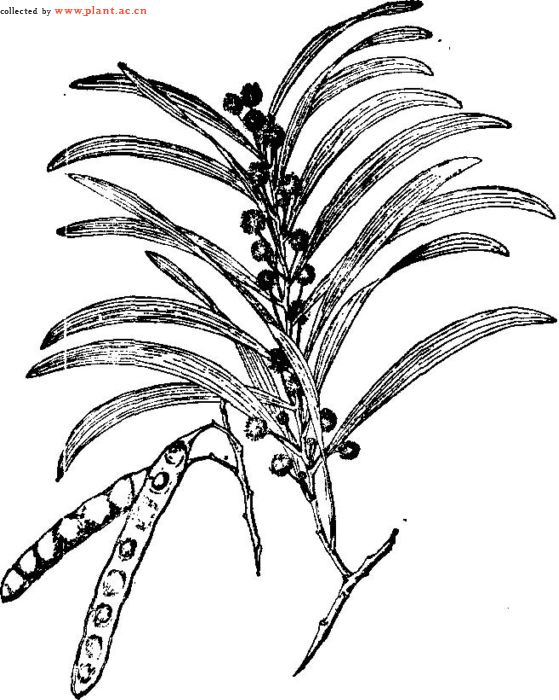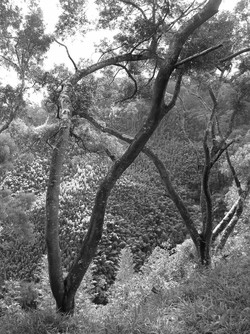 Bildquelle. Die Pflanze.
Bildquelle. Die Pflanze. Bildquelle. Die Pflanze.
Bildquelle. Die Pflanze.
small Philippine acacia (engl.). (USDA) Acacia richii auct. non A. Gray; Racosperma confusum (Merr.) Pedley; Acacia Petit Feuille; Mimosa; (#147)
Leguminosae - Huelsenfruechtler
Die getrockneten Staemme sollen laut einer Usenetquelle 0,04% N-Methyltryptamin und 0,02 % DMT (Dimethyltryptamin) enthalten. (Die Quelle verweist auf eine Arbeit von Arthur et al. aus dem Jahr 1967.)(Usenet) Jonathan Ott schreibt auch in "Ayahuasca Analogues", dass nur Spuren von halluzinogenen/entheogenen Tryptaminen in dieser Pflanze enthalten sind. (#57/81)
DMT und NMT in den Blaettern, Stamm und Rinde; 0.04% NMT und 0.02% DMT im Stamm. Auch N,N-Dimethyltryptamine-N-oxide. (Wikipedia)
N-Chlormethyl-N,N-dimethyltryptamin, N-Methyltryptamin, DMT, und DMT-N-oxid nach dem Bericht von Quinn et al. aus dem Jahr 2006. (Neurosoup)
Asien: China (einheimisch): Fujian, Guangdong, Guangxi, Yunnan; India (eingefuehrt): Delhi, Karnataka, Tamil Nadu; Indonesien (eingefuehr), Java (eingefuehrt), Malaysien (eingefuehrt), Philippinen (einheimisch), Ryukyu Inseln (eingefuehrt), Sabah (eingefuehrt), Sumatra(eingefuehrt), Taiwan(einheimisch), Vietnam(eingefuehrt); Indischer Ozean: Mauritius(eingefuehrt), Seychelles(eingefuehrt); Pazifischer Ozean: Northern Marianas (eingefuehrt), Ogasawara-Shoto(eingefuehrt); (#147)
Diese Pflanze gehoert zur Familie der Akazien (Acacia). Einzelne Vertreter dieser Familie sind vor allem fuer die Produktion von Gummi arabicum bekannt geworden. (eigen) Erst in letzterer Zeit haeufen sich Berichte ueber psychoaktive Inhaltsstoffe in dieser Pflanzenfamilie. Einzelne Acacia-Arten enthalten ss-Karboline, aber auch halluzinogeneTryptamine, (&1, #55, #62) welche uebrigens im Pflanzenreich weit verbreitet sind. So sind beispielsweise viele Virola-Arten tryptaminhaeltig, aber auch die Halluzinogene enthaltenden Pilzfamilien Panaeolus, Psilocybe, Pluteus, und andere, erhalten ihre Wirkung durch die halluzinogenen Tryptamine Psilocin, Psilocybin und Baeocystin. Auch die Rauschdroge ayahuaska basiert auf der Wirkung von halluzinogenen Tryptaminen, vor allem auf den Gehalt von DMT und 5-Methoxy-DMT. (eigen)
Aufgrund des geringen Alkaloidgehaltes dieser Pflanze ist nur mit einer schwachen Wirkung zu rechnen. Dennoch koennten Konzentrate aus dieser Pflanze eine Rolle als Halluzinogen spielen, denn die Inhaltsstoffe sind eindeutig hochaktiv halluzinogen. Eine Wirkung wuerde v.a. auf dem Hauptinhaltsstoff DMT (Dimethyltryptamin) beruhen, der aus einer Reihe von Pflanzen und Rauschdrogenbereitungen bekannt ist. Es soll hier nur kurz an die Virola-Schnupfpulver oder auch an die DMT--haeltige Winde Banisteriopsis rusbyana, die eine der Grundlagen fuer das Rauschgetraenk ayahuasca Amazoniens bildet, verwiesen werden. (eigen)
C. Raetsch meint, in seiner "Enzyklopaedie der psychoaktiven Pflanzen", dass die Pflanze fuer ayahuaska-Bereitungen brauchbar sei. Welcher Teil der Pflanze dabei in seinen Augen verwendet wird, hat er nicht niedergeschrieben. (eigen)
 Bildquelle. Die Pflanze.
Bildquelle. Die Pflanze.
Aus dem Internet stammt folgende Beschreibung fuer eine A.c. Extraktion:
1. Take your glass vinegar bottle and make shure it is washed thoroughly throughout.
2. Now Measure 200ml of water in your glass measuring jug and pour this into your vinegar bottle with one of your filters.
3. If you have a strong blender, powder down the Acacia Confusa bark so it has a wider surface area. I use a 600w philips blender which does the job! (dont worry if you don't own a blender you can get away with using just shreeded bark)
4. Filter in approximately 20g of (powdered or shreeded) Acacia Confusa Bark into your bottle, and give a vigourous shake to strip down the bark (it should look like slightly red)
5. Now store this solution in a dark, undisturbed part of your working area at room temperature overnight! (I use my bedroom cabinet and would store for 24hours, shaking every now 4-6hours)
6. Once 24 hours has passed will now need to perform a defat
7. Measure out 50ml of Naphtha with your measuring Jug and then continue to add this to your vinegar bottle using one of your small filters
8. Start shaking your solution for around 4-6 minutes (from what i have learnt the defat removes the unwanted alkaloids, so be sure to give it a ruddy good shake)
9. Start running a hot water bath @ 60c (You may be limited to your resources! So SWIM used a sink with the hot water tap which was filled up to the top with the hottest water it could produce. This came out to around 45c – 51c which is satisfactory)
10. Place your solution in the hot water bath (this does help speed up the process of the defat, after around 30 - 60 mins, both layers will have sperated)
11. Using your pipette python out the top layer of naphtha and store in one of your plastic pill bottle (make sure to name it something like ''defat bottle'' and eventually dispose ofit in the right way!)
12. Repeat steps 7 to 11 one more time
13. Now you have finished the defat stage, Measure out 5g of caustic soda and to add to your solution using a filter (remember to use googles, gloves and dusk mask when dealing with caustic soda, if u dont and get it on your hands it hurts, i know you heard it billion times, BUT MAINTAIN SAFETY!!!)
14. Give the bottle a shake, it will turn from dark red to dark black
(The next procedure is exactly like the defat, only we will use our solvent to remove the NN-DMT from the bark)
15. Measure out 50ml of Naphtha with your measuring Jug and then continue to add this to your vinegar bottle using one of your small filters
16. Start running another hot water bath and place the bottle in your hot water bath for 30 minutes
17. After 30minutes have passed, take your solution and give it a shake for 2-4 minutes (being careful not to create any froth on top of your solution, this is called ''emulsions'' which stops the seperation of the solvent on top from the soupy liquid below)
18. Now run another hot water bath and place your solutuion init, waiting for around 1-2 hours (or how ever long until the 2 layers have seperated)
19. After a couple hours, the layers will have seperated, Using your pipette python out the top layer of naphtha and store in your other glass pill bottle (this is the sovlent that contains your dmt)
20. Repeat steps 15 - 19 another 2 times
21. Now get your glass baking dish and pour the dmt into the dish (making sure no soupy dark liquid is in the solvent)
22. Place your glass baking dish in the freezer for 24 hours
23. Remove your glass baking dish and python of the remaining solvent while being careful not to python up any of the white crystals (the remaining solvent can be stored for use again in steps 15-19)
24. Place your dish in a cool dark area i use my bedroom cabinet with a vinyl record case placed on top so no oxygen or light gets to the crystals (you will notice if you crystals have prolonged exposure to light and air they will become orangey / yellow)
25. After the crystals have fully dried, use a razor blade to scrape up the crystals and store within a clean new dodgy bag (i would store this dodgy bag within another 2 dodgy bags within 2 boxes stored in a dark area)
NOTES: SWIM has found from extracting 20g of Acacia Confusa using this tek swim can produce a yeild of 0.1g (100mg) of white-ish pure NN-DMT xtals, swim has noticed and from others experiences that acacia is slightly more stronger than mimosa, this might be down to another present alkaloid in the acacia called ''NMT'' (even thruogh its present in mimosa aswell)
Allthrough NN-DMT extracted from Acacia is slightly more powerful the downside is that you only get 0.1g from 20g bark extraction, as apose to mimosa in which you could produce 0.2g from 20g bark extraction. If anyone out there using this tek and getting better results than swim, please pm swim so can incorparate your method into the tek. (Internet)
Es ist weder eine koerperliche, noch eine glaubhafte, geistige Abhaengigkeit bekannt geworden. (eigen)
1967: Arthur et al. isolierten N-Methyltryptamin und DMT aus dieser Pflanze. (#57/81)
2006: Quinn et al. berichten ueber einen Alkaloidgehalt, u.a. DMT. (Neurosoup)
Abbildung 1: Zeichner/in: unbekannt; Quelle: www.plant.ac.cn.
Abbildung 2: Photograph/in: unbekannt; Quelle: Wikipedia;